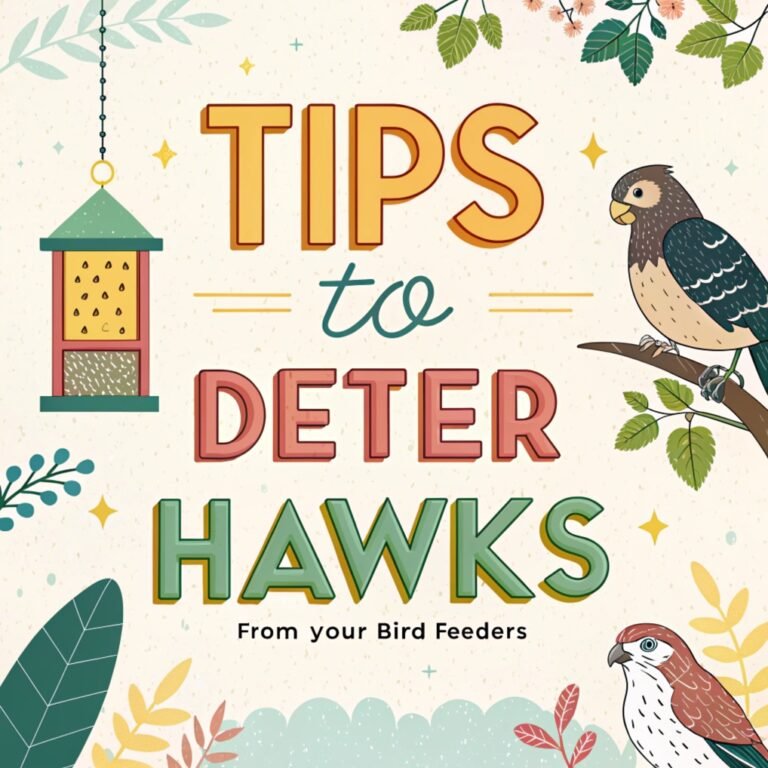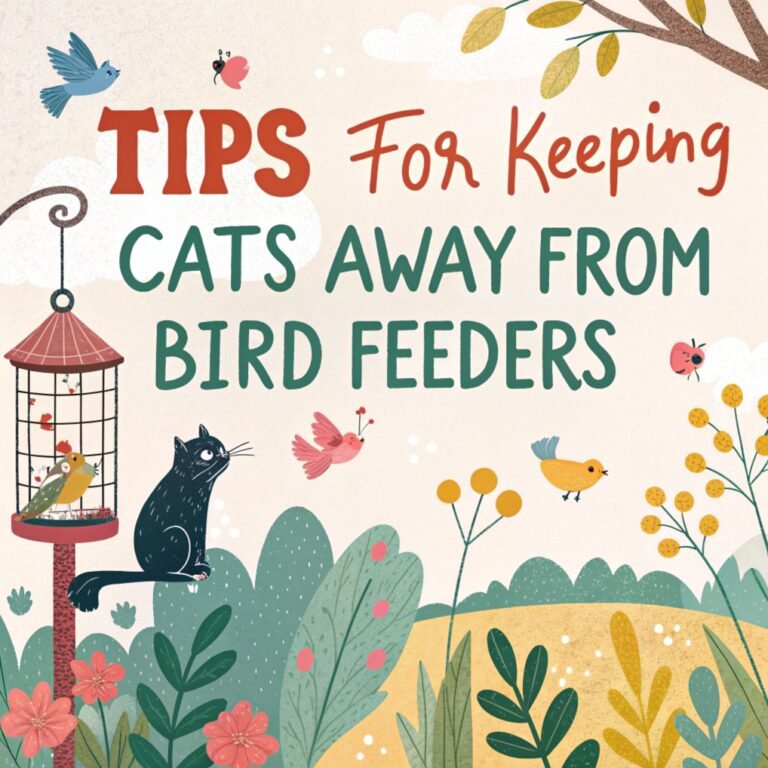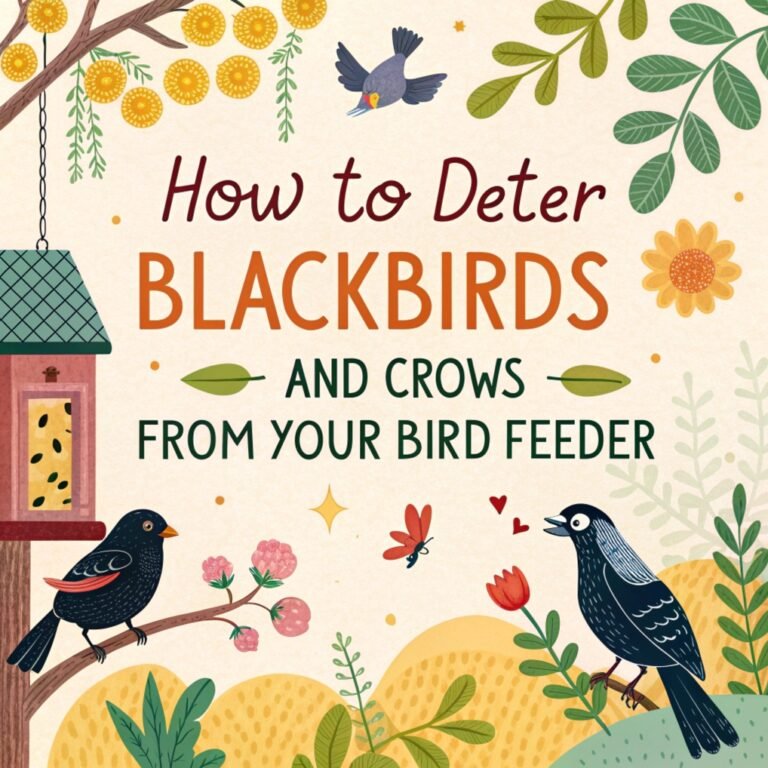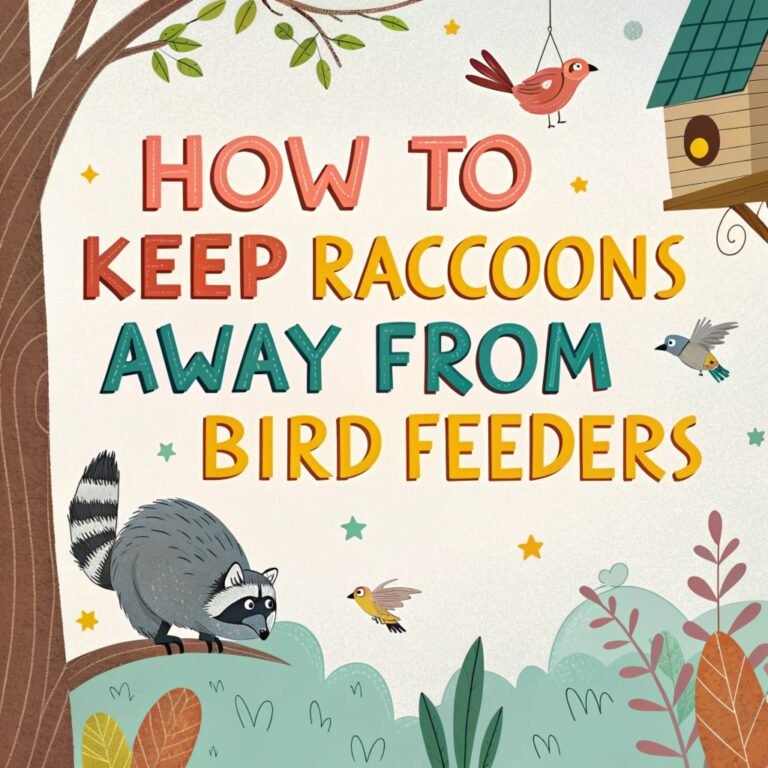Ways to Keep Raccoons Off Your Bird Feeders and Protect Your Feathered Friends
Bird feeding is a delightful hobby that brings joy to many, but it can quickly turn frustrating when raccoons start raiding your feeders.
These clever and persistent creatures can empty a bird feeder in no time, leaving your feathered friends without their much-needed nourishment.
However, with the right strategies and a bit of ingenuity, you can successfully keep raccoons at bay and ensure that your bird feeders remain a safe haven for the birds you love.
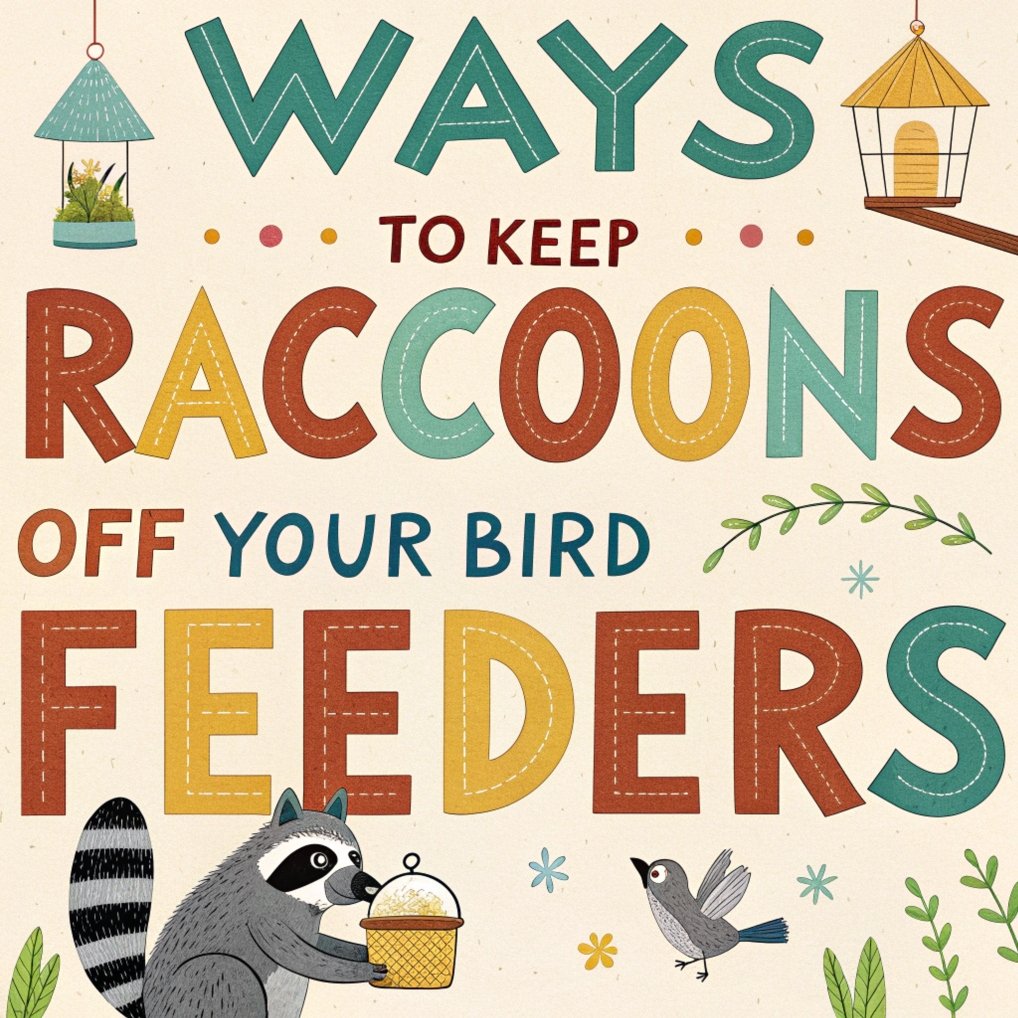
Key Takeaways:
- Understand raccoon behavior to effectively deter them
- Use proper baffles designed specifically for raccoons
- Strategically place feeders away from climbing access points
- Implement clean feeding practices to reduce attraction
- Consider timing of feeder availability
- Explore raccoon-resistant feeder designs
- Employ multiple deterrent methods for best results
- Maintain consistency in your raccoon-proofing efforts
- Adapt your strategies as needed based on raccoon activity
- Prioritize bird safety in all deterrent methods
Understanding Raccoon Behavior: The First Step in Effective Deterrence
To effectively keep raccoons off your bird feeders, it’s crucial to understand their behavior. Raccoons are nocturnal creatures, meaning they are most active during the night.
This nighttime activity pattern is a key factor in their feeding habits and can be used to your advantage when implementing deterrent strategies.
Raccoons are also known for their intelligence and dexterity. Their problem-solving skills and nimble paws allow them to overcome many obstacles, making them formidable opponents in the quest to protect bird feeders.
These animals are opportunistic feeders, always on the lookout for easy meals. Bird feeders, with their concentrated food source, are particularly attractive to these resourceful creatures.
Understanding these behavioral traits will help you develop more effective strategies to keep raccoons away from your bird feeders.
By focusing on nighttime protection and creating obstacles that challenge even their clever minds, you can significantly reduce raccoon raids on your feeders.
Implementing Raccoon-Specific Baffles: A Crucial Line of Defense
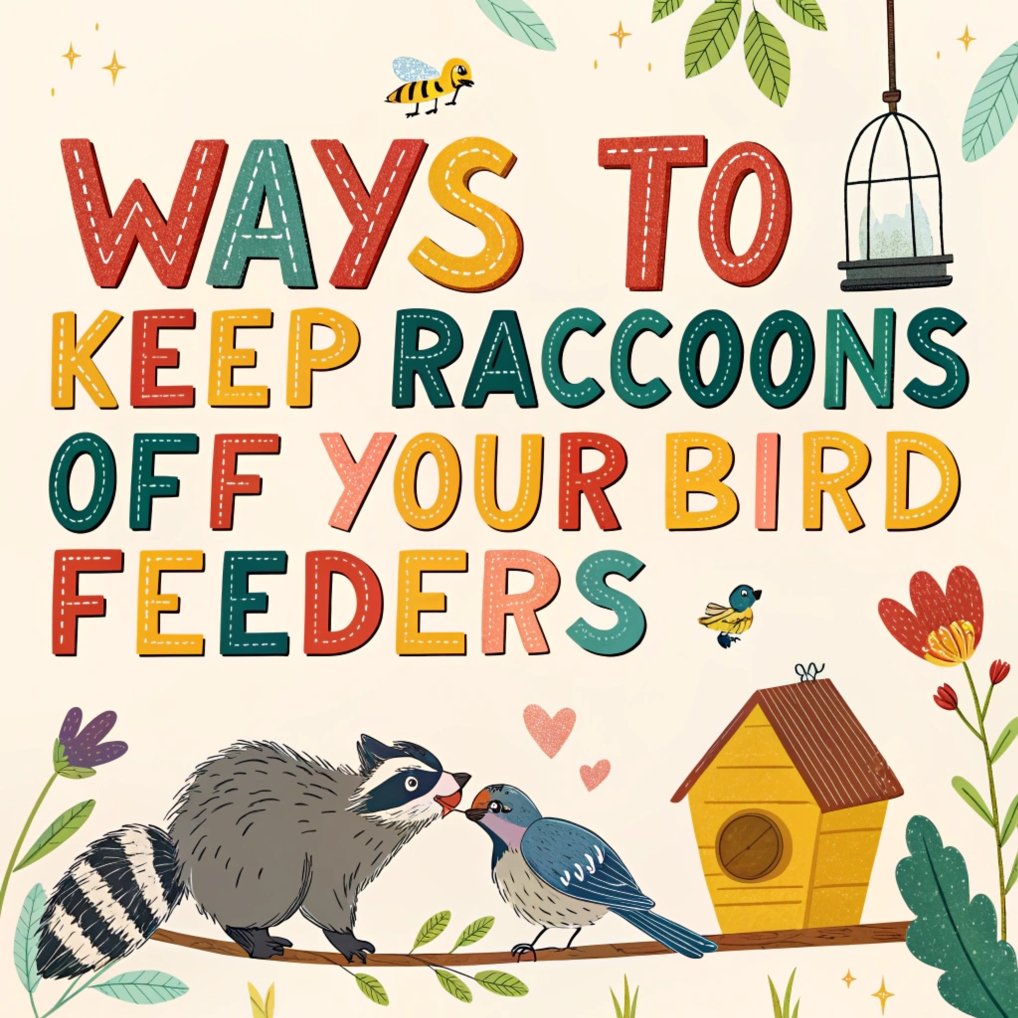
One of the most effective ways to keep raccoons off your bird feeders is by using raccoon-specific baffles.
These devices are designed to prevent raccoons from climbing up to your feeders, acting as a physical barrier that these clever creatures can’t overcome.
Unlike squirrel baffles, raccoon baffles need to be much larger and sturdier. A typical raccoon baffle should be at least 15-18 inches in diameter and made of smooth, durable material that raccoons can’t grip.
When installing a baffle, ensure it’s placed at least 4 feet above the ground to prevent raccoons from jumping over it.
For pole-mounted feeders, consider wrapping a smooth sheet of metal around the pole up to 4 feet high, then placing a wide baffle above that.
This double barrier approach can be highly effective in stopping raccoons from climbing. Remember, proper installation is key to the baffle’s effectiveness, so follow manufacturer guidelines closely.
Strategic Feeder Placement: Outsmarting the Clever Climbers
Strategic placement of your bird feeders is crucial in keeping raccoons at bay. These agile creatures are excellent climbers and can jump impressive distances, so careful consideration of your feeder location is essential.
Firstly, keep feeders away from trees, tall structures, or your house. Raccoons can easily climb these and jump onto nearby feeders.
Aim to place feeders at least 10 feet away from any potential launching points. If possible, mount feeders on standalone poles in open areas of your yard.
Consider using thin poles less than half an inch in diameter for your feeders. These are typically too thin for raccoons to climb effectively.
Alternatively, you can suspend feeders from wires stretched between two structures. Ensure the wire is taut and the feeder is placed in the middle, making it difficult for raccoons to reach.
Remember, raccoons are resourceful, so regularly assess your feeder placement and make adjustments if you notice any raccoon activity. By making your feeders less accessible, you significantly reduce the chances of raccoon raids.
Clean Feeding Practices: Reducing Attraction and Maintaining Hygiene
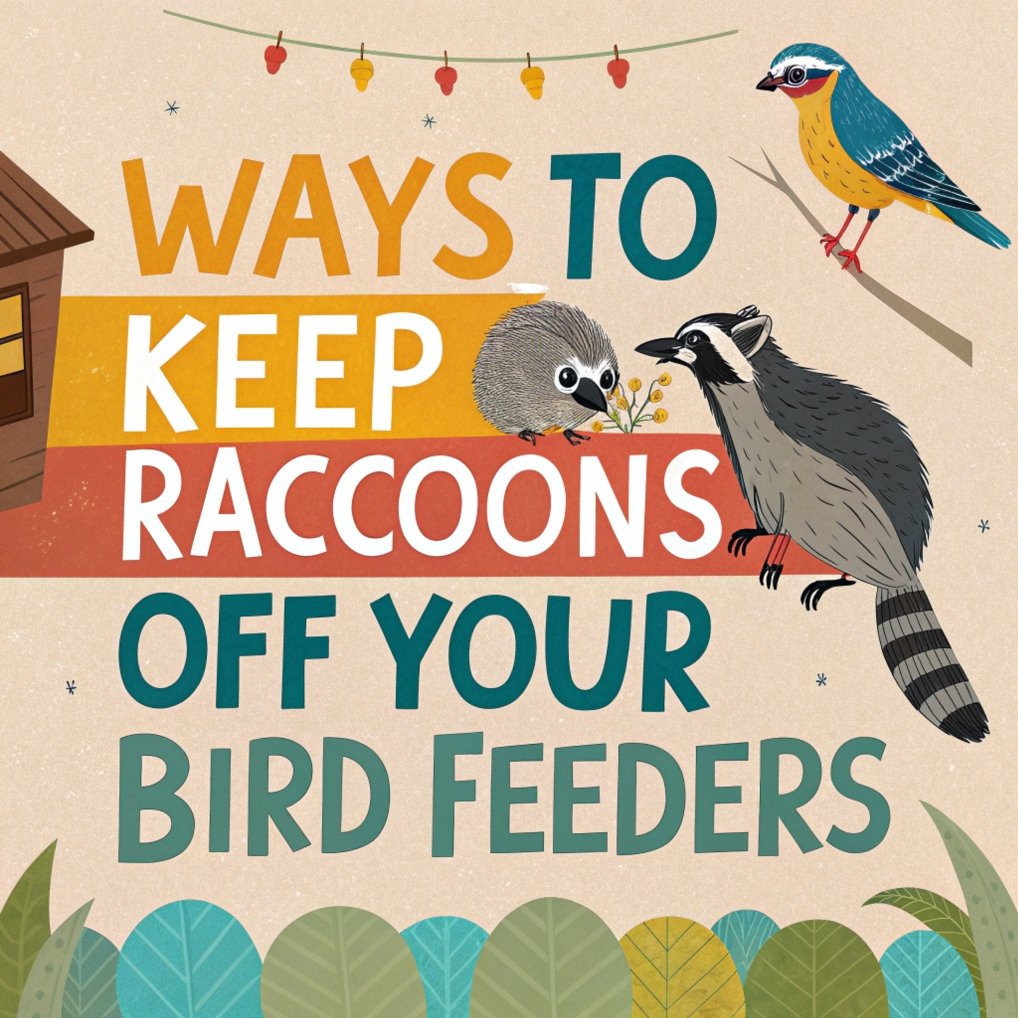
Implementing clean feeding practices is not only beneficial for the birds but also helps in deterring raccoons. Spilled seed on the ground can attract raccoons and other unwanted wildlife, so keeping your feeding area tidy is crucial.
Start by using feeders designed to minimize spillage. Many modern bird feeders come with built-in seed catchers or trays that collect fallen seeds. If your current feeders don’t have this feature, consider adding a separate seed catcher beneath them.
Regularly clean up any spilled seed from the ground around your feeders. This not only reduces attraction for raccoons but also prevents the growth of mold and bacteria that can be harmful to birds.
Consider using a single type of seed in each feeder rather than seed mixes, as birds tend to scatter seeds they don’t prefer, leading to more ground spillage.
Maintain a regular cleaning schedule for your feeders. Wash them thoroughly with a mild soap solution every few weeks, more often during wet weather.
This practice not only keeps raccoons away but also ensures a healthy feeding environment for your feathered visitors.
Timing is Everything: Adjusting Feeder Availability
Leveraging the nocturnal nature of raccoons can be an effective strategy in keeping them away from your bird feeders. By adjusting when your feeders are available, you can significantly reduce raccoon access while still providing for the birds.
Consider bringing in your feeders at night, when raccoons are most active. This can be particularly effective if you use hanging feeders or those that are easily detachable.
Set up a routine of taking down the feeders at dusk and putting them back up at dawn.
If removing feeders nightly isn’t feasible, try filling your feeders with only enough seed for one day. Observe your birds’ feeding patterns and estimate how much they consume daily.
By ensuring the feeders are empty by nightfall, you remove the incentive for raccoons to visit.
For those using electronic feeders, some models allow you to set specific feeding times. Program these to close at night, effectively locking out nocturnal raiders while still providing food during daylight hours when birds are active.
Raccoon-Resistant Feeder Designs: Investing in Smart Solutions
Investing in raccoon-resistant feeder designs can be a game-changer in your efforts to keep these clever creatures at bay. Many manufacturers now offer feeders specifically designed to thwart raccoon attempts at accessing bird food.
Look for feeders with weight-activated perches that close access to seed ports when a heavy animal like a raccoon tries to feed. These feeders typically allow smaller birds to feed freely while shutting out heavier visitors.
Caged feeders are another excellent option. These consist of a regular feeder enclosed within a wire cage. The spacing of the wire allows small birds to enter and feed while keeping larger animals like raccoons out.
Some feeders come with built-in baffles or guards that make it difficult for raccoons to reach the feeding ports. These designs often incorporate smooth, slippery surfaces that raccoons can’t grip.
Consider feeders made of chew-resistant materials like metal or high-strength plastics. Raccoons have strong teeth and can easily damage softer materials, so durability is key.
Utilizing Natural Deterrents: Harmless Yet Effective Methods
While physical barriers and specialized feeders are effective, natural deterrents can add an extra layer of protection against raccoons. These methods are typically harmless to both raccoons and birds, making them an excellent eco-friendly option.
Strong scents can be off-putting to raccoons. Consider planting mint or lavender near your feeding stations, as raccoons tend to dislike these aromas.
You can also try sprinkling cayenne pepper around the base of your feeder poles, but be cautious not to let it get into the bird food.
Some bird enthusiasts have found success with motion-activated sprinklers. These devices detect movement and spray a burst of water, startling raccoons and other unwanted visitors. Place these strategically around your feeding area for best results.
Bright lights can also deter raccoons. Consider installing motion-sensor lights near your feeders. The sudden illumination can startle raccoons and make them feel exposed, encouraging them to leave the area.
Remember, while these methods can be effective, raccoons are adaptable. Rotate your deterrent methods regularly to prevent the raccoons from becoming accustomed to any one strategy.
Securing Your Yard: Broader Raccoon Prevention Strategies
Keeping raccoons away from your bird feeders often requires a holistic approach that extends beyond the immediate feeding area.
Implementing broader raccoon prevention strategies in your yard can significantly reduce overall raccoon activity.
Start by securing your trash cans. Use bins with tight-fitting, locking lids that raccoons can’t pry open. If possible, store garbage bins in a shed or garage until collection day.
This removes a major food source that might be attracting raccoons to your property in the first place.
Remove other potential food sources from your yard. Pick up fallen fruit from trees, clean up pet food left outdoors, and ensure compost bins are securely closed. The less accessible food there is in your yard, the less likely raccoons are to frequent the area.
Consider installing motion-sensor lights around your property. While primarily used for security, these can also deter raccoons who prefer to operate in darkness.
Trim back tree branches that might provide easy access to your roof or upper stories, as raccoons often use these as highways to move around properties.
Consistency is Key: Maintaining Your Raccoon-Proofing Efforts
When it comes to keeping raccoons off your bird feeders, consistency in your deterrent efforts is crucial. Raccoons are persistent creatures, and a lapse in your prevention strategies can quickly undo all your hard work.
Regularly inspect your deterrent measures to ensure they’re functioning properly. Check baffles for any damage or wear, and make sure they’re still properly positioned. If you’re using scent deterrents, reapply them as needed, especially after rain.
Stay vigilant in your cleaning routine. Consistently clean up spilled seed and maintain the hygiene of your feeders. This not only deters raccoons but also promotes the health of your visiting birds.
If you’re bringing feeders in at night, stick to this routine even if you haven’t seen raccoon activity for a while.
Raccoons may be waiting for an opportunity to return, and consistency in your prevention methods will discourage them from revisiting.
Remember to regularly reassess your strategies. What works one season might be less effective in another, especially as raccoons learn and adapt. Be prepared to adjust your methods as needed to stay one step ahead of these clever creatures.
Balancing Raccoon Deterrence with Bird-Friendly Practices
While keeping raccoons away from your bird feeders is important, it’s equally crucial to ensure that your deterrent methods don’t negatively impact the birds you’re trying to feed.
Striking this balance requires thoughtful consideration and careful implementation of your chosen strategies.
Avoid using any chemicals or substances that could harm birds. While some might suggest using sticky substances or grease on feeder poles, these can be dangerous if they get on birds’ feathers, affecting their ability to fly and stay warm.
When using baffles or cages, ensure they don’t pose a risk to birds. Check regularly for any sharp edges or places where birds might get trapped.
If using weight-activated feeders, make sure they’re calibrated correctly to allow access for larger birds you want to feed, like cardinals or jays.
Consider providing multiple feeding stations with different types of protection. This can help ensure that even if raccoons manage to access one feeder, others remain available for the birds.
It also allows you to cater to different bird species’ preferences and feeding habits.
Remember, the goal is to create a safe and welcoming environment for birds while deterring raccoons. Regular observation of bird behavior around your feeders can help you fine-tune your approach, ensuring your yard remains a haven for your feathered friends.
FAQs
What is the most effective baffle size for deterring raccoons?
The most effective baffle size for deterring raccoons is typically 15-18 inches in diameter. It should be made of smooth, durable material and placed at least 4 feet above the ground to prevent raccoons from jumping over it.
Can hot pepper additives in bird seed deter raccoons?
Yes, hot pepper additives can deter raccoons. Birds lack the receptors to feel the heat from capsaicin, the compound that makes peppers hot, while mammals like raccoons find it unpleasant. However, it’s important to use commercially prepared hot pepper bird foods rather than adding loose pepper to seed, as loose pepper can be harmful if inhaled by birds.
How high should I hang my bird feeders to keep them out of raccoons’ reach?
To keep bird feeders out of raccoons’ reach, hang them at least 5-6 feet off the ground and 10 feet away from any structures or trees that raccoons could climb. Remember that raccoons can jump up to 4 feet vertically, so additional protection like baffles may be necessary.
Are there any plants that naturally repel raccoons?
While no plant is guaranteed to repel raccoons completely, some plants that raccoons tend to dislike include lavender, peppermint, garlic, and marigolds. Planting these around your feeding area may help deter raccoons, but should be used in conjunction with other deterrent methods for best results.
How often should I clean my bird feeders to discourage raccoons?
To discourage raccoons and maintain bird health, clean your bird feeders thoroughly every two weeks, or more frequently during wet weather or if you notice any signs of mold or bacteria. Regular cleaning not only deters raccoons but also prevents the spread of diseases among birds.

Hello, I’m Amelia White, the founder of birdsfanatic.com. As a lifelong bird enthusiast and spiritual seeker, I’ve always been fascinated by the mystical connections between birds and the human experience. On this site, I share my knowledge and insights into the symbolic meanings and spiritual significance of various bird species, exploring their roles in mythology, folklore, and cultural traditions. Join me on this journey into the world of birds, where we’ll discover the hidden wisdom and guidance that these magnificent creatures have to offer.


